Abstract
Carcinogenesis is a multistep process involving alterations in at least two distinct classes of genes. Protooncogenes are activated qualitatively or quantitatively in certain tumors, and they appear to act as positive proliferative signals for neoplastic growth. In contrast, tumor suppressor genes are normal genes that must be inactivated or lost for tumor development. When active, tumor suppressor genes control neoplastic growth in a negative manner. Chemicals may influence the carcinogenic process by mutational activation of protooncogenes and/or inactivation of tumor suppressor genes. The types of genetic alterations involved in these mutational events are diverse, and their dose-response curves may be varied. In addition, chemical carcinogens may act on nonmutational processes such as the clonal expansion of premalignant cells. The carcinogenic risk of a specific chemical is a composite of its effects on multiple genetic and epigenetic processes.
Full text
PDF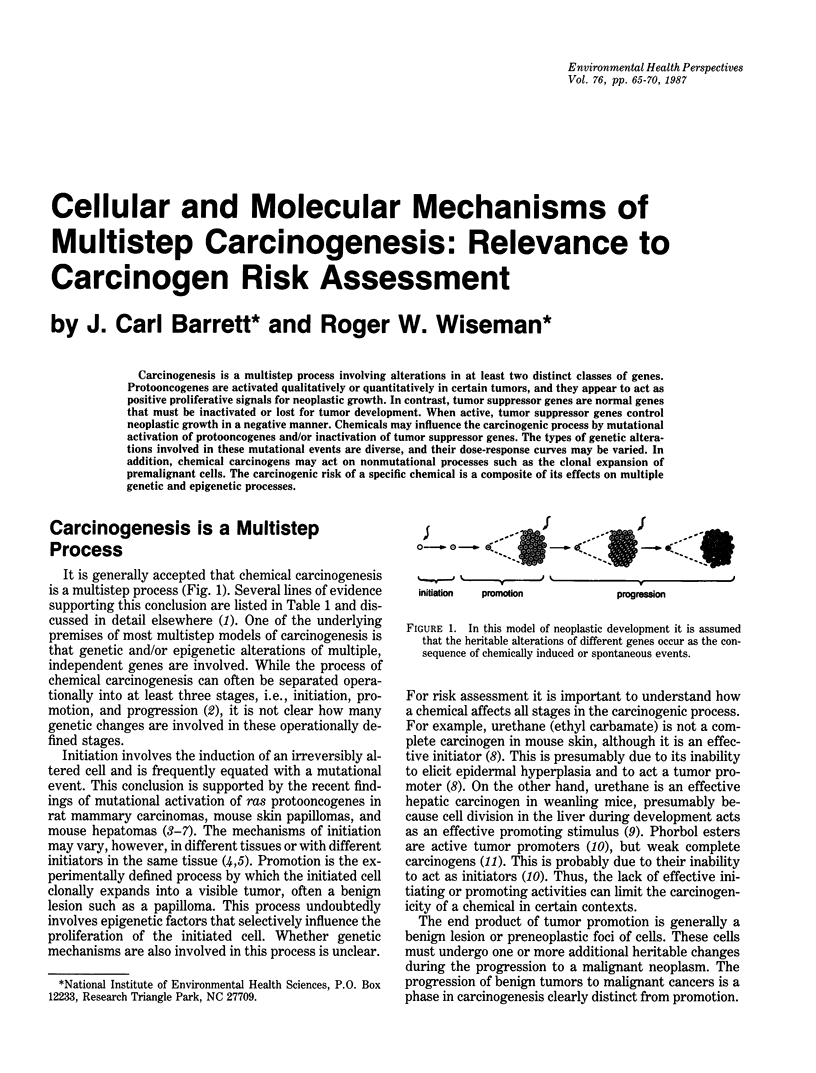
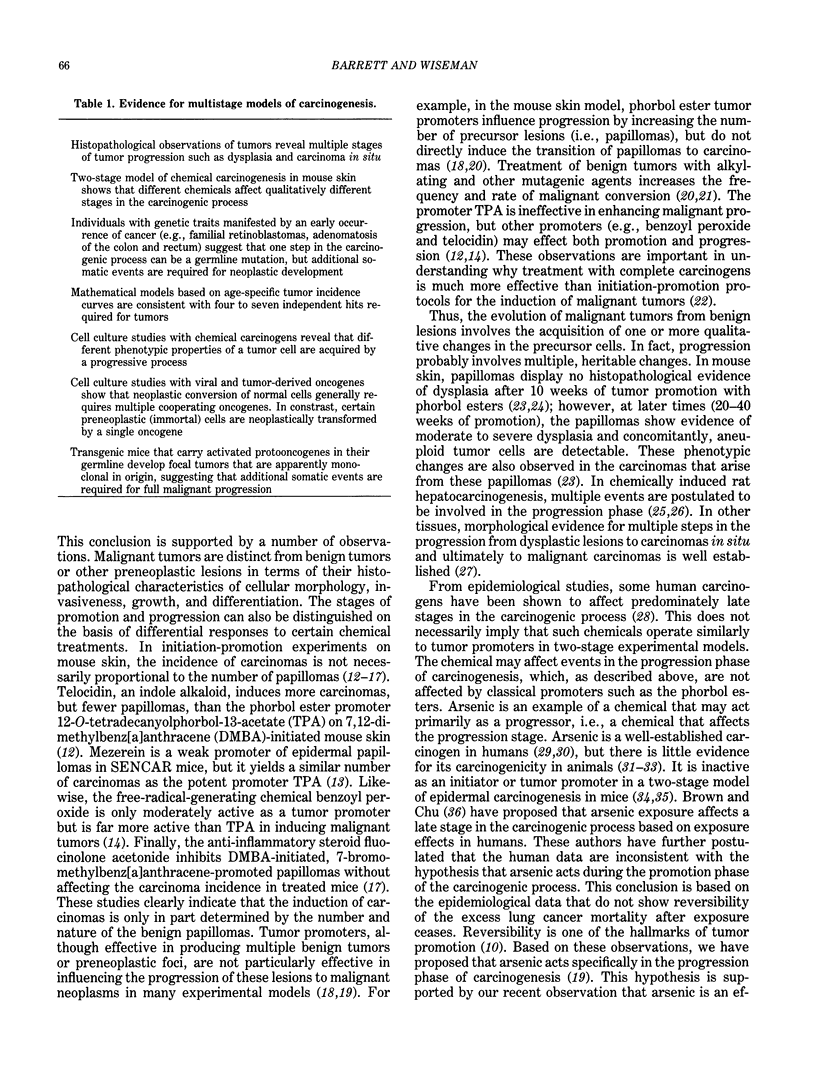
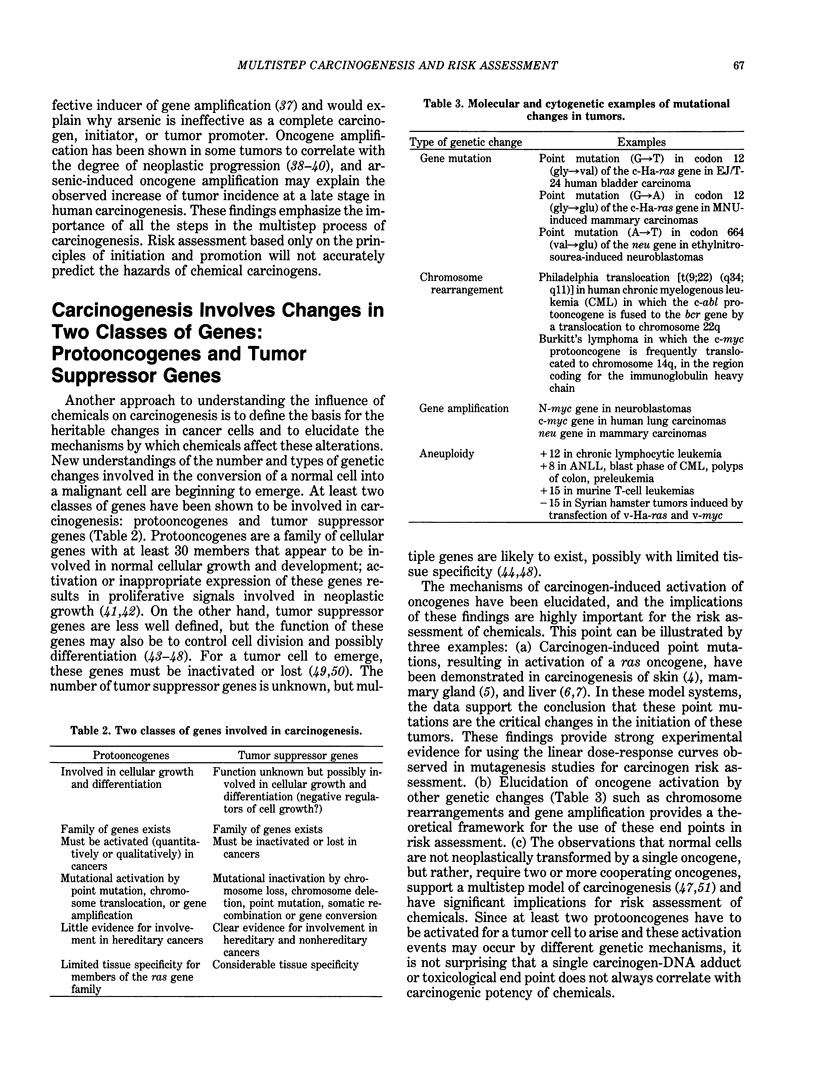
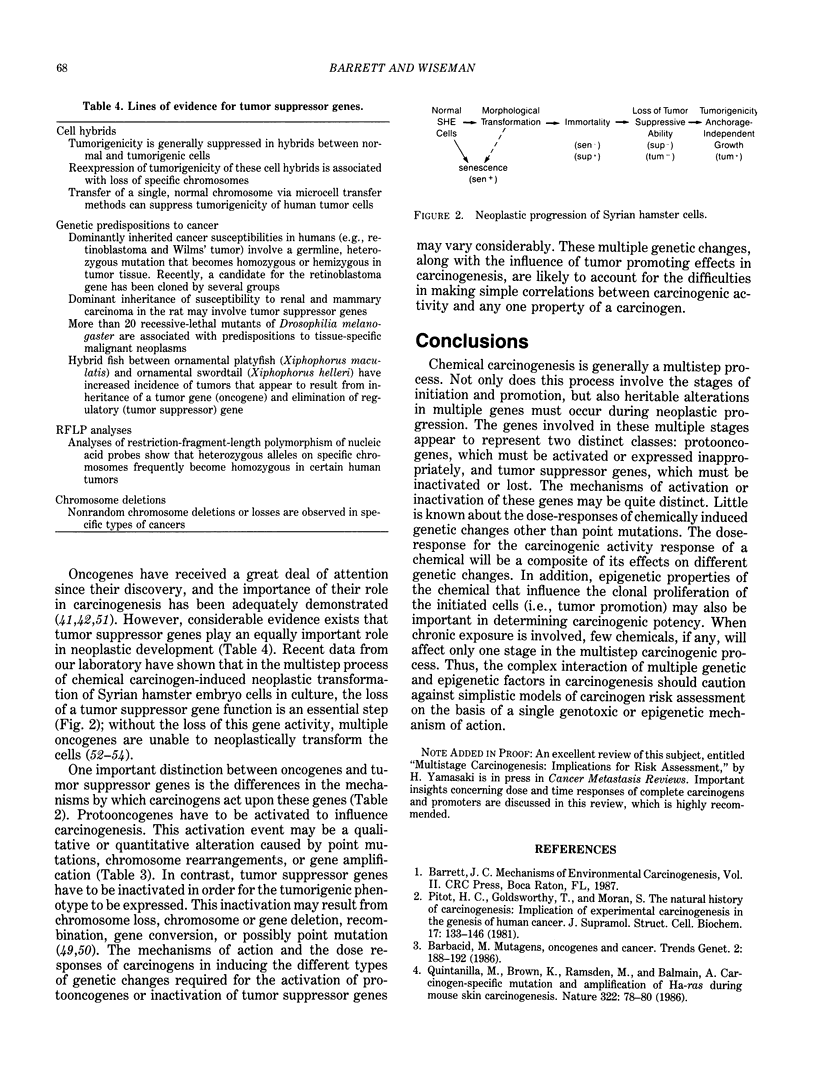
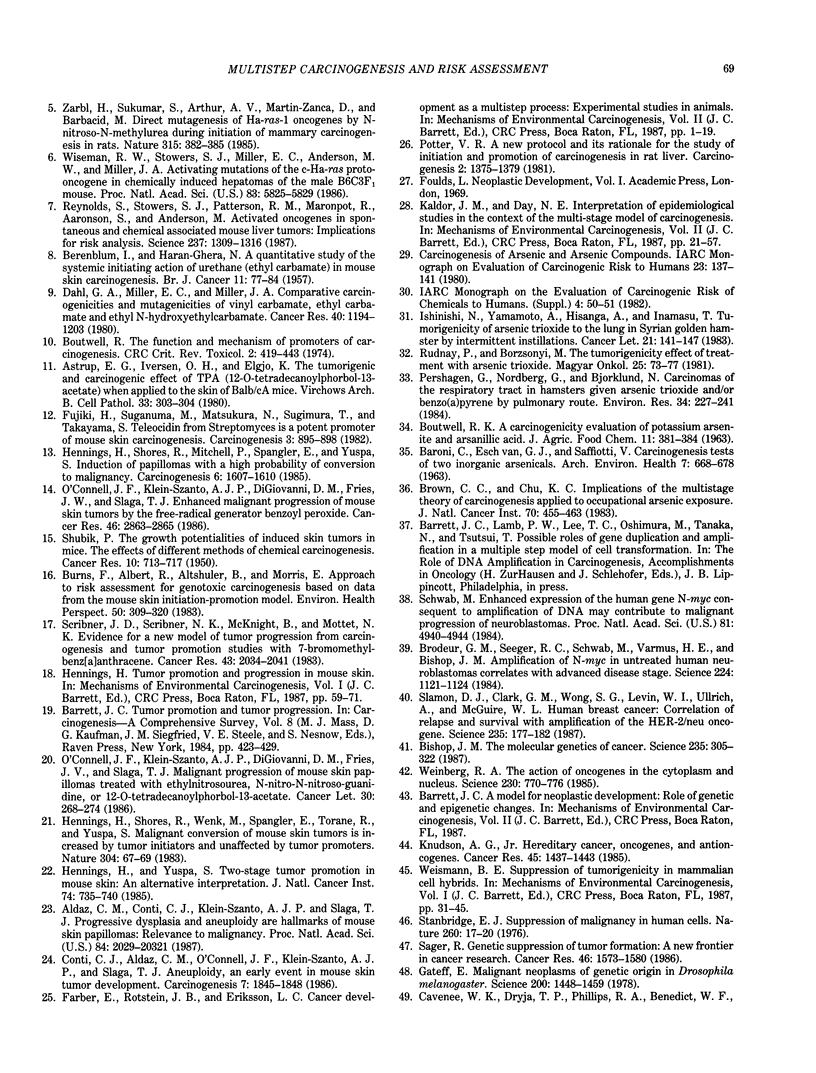
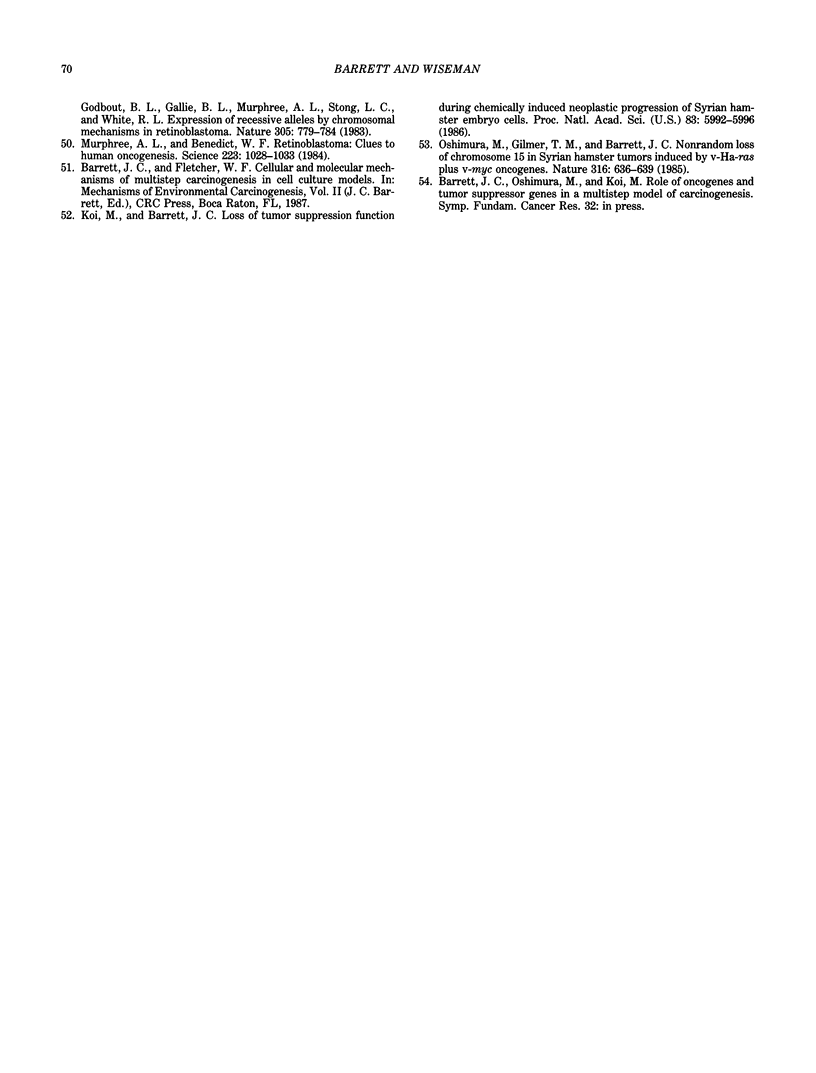
Selected References
These references are in PubMed. This may not be the complete list of references from this article.
- Aldaz C. M., Conti C. J., Klein-Szanto A. J., Slaga T. J. Progressive dysplasia and aneuploidy are hallmarks of mouse skin papillomas: relevance to malignancy. Proc Natl Acad Sci U S A. 1987 Apr;84(7):2029–2032. doi: 10.1073/pnas.84.7.2029. [DOI] [PMC free article] [PubMed] [Google Scholar]
- Astrup E. G., Iversen O. H., Elgjo K. The tumorigenic and carcinogenic effect of TPA (12-0-tetradecanoylphorbol-13-acetate) when applied to the skin of BALB/cA mice. Virchows Arch B Cell Pathol Incl Mol Pathol. 1980;33(3):303–304. [PubMed] [Google Scholar]
- BARONI C., VAN ESCHG, SAFFIOTTI U. CARCINOGENESIS TESTS OF TWO INORGANIC ARSENICALS. Arch Environ Health. 1963 Dec;7:668–674. doi: 10.1080/00039896.1963.10663598. [DOI] [PubMed] [Google Scholar]
- BERENBLUM I., HARAN-GHERA N. A quantitative study of the systemic initiating action of urethane (ethyl carbamate) in mouse skin carcinogenesis. Br J Cancer. 1957 Mar;11(1):77–84. doi: 10.1038/bjc.1957.11. [DOI] [PMC free article] [PubMed] [Google Scholar]
- Bishop J. M. The molecular genetics of cancer. Science. 1987 Jan 16;235(4786):305–311. doi: 10.1126/science.3541204. [DOI] [PubMed] [Google Scholar]
- Boutwell R. K. The function and mechanism of promoters of carcinogenesis. CRC Crit Rev Toxicol. 1974 Jan;2(4):419–443. doi: 10.3109/10408447309025704. [DOI] [PubMed] [Google Scholar]
- Brodeur G. M., Seeger R. C., Schwab M., Varmus H. E., Bishop J. M. Amplification of N-myc in untreated human neuroblastomas correlates with advanced disease stage. Science. 1984 Jun 8;224(4653):1121–1124. doi: 10.1126/science.6719137. [DOI] [PubMed] [Google Scholar]
- Brown C. C., Chu K. C. Implications of the multistage theory of carcinogenesis applied to occupational arsenic exposure. J Natl Cancer Inst. 1983 Mar;70(3):455–463. [PubMed] [Google Scholar]
- Burns F., Albert R., Altshuler B., Morris E. Approach to risk assessment for genotoxic carcinogens based on data from the mouse skin initiation-promotion model. Environ Health Perspect. 1983 Apr;50:309–320. doi: 10.1289/ehp.8350309. [DOI] [PMC free article] [PubMed] [Google Scholar]
- Cavenee W. K., Dryja T. P., Phillips R. A., Benedict W. F., Godbout R., Gallie B. L., Murphree A. L., Strong L. C., White R. L. Expression of recessive alleles by chromosomal mechanisms in retinoblastoma. 1983 Oct 27-Nov 2Nature. 305(5937):779–784. doi: 10.1038/305779a0. [DOI] [PubMed] [Google Scholar]
- Conti C. J., Aldaz C. M., O'Connell J., Klein-Szanto A. J., Slaga T. J. Aneuploidy, an early event in mouse skin tumor development. Carcinogenesis. 1986 Nov;7(11):1845–1848. doi: 10.1093/carcin/7.11.1845. [DOI] [PubMed] [Google Scholar]
- Dahl G. A., Miller E. C., Miller J. A. Comparative carcinogenicities and mutagenicities of vinyl carbamate, ethyl carbamate, and ethyl N-hydroxycarbamate. Cancer Res. 1980 Apr;40(4):1194–1203. [PubMed] [Google Scholar]
- Fujiki H., Suganuma M., Matsukura N., Sugimura T., Takayama S. Teleocidin from Streptomyces is a potent promoter of mouse skin carcinogenesis. Carcinogenesis. 1982;3(8):895–898. doi: 10.1093/carcin/3.8.895. [DOI] [PubMed] [Google Scholar]
- Gateff E. Malignant neoplasms of genetic origin in Drosophila melanogaster. Science. 1978 Jun 30;200(4349):1448–1459. doi: 10.1126/science.96525. [DOI] [PubMed] [Google Scholar]
- Hennings H., Shores R., Mitchell P., Spangler E. F., Yuspa S. H. Induction of papillomas with a high probability of conversion to malignancy. Carcinogenesis. 1985 Nov;6(11):1607–1610. doi: 10.1093/carcin/6.11.1607. [DOI] [PubMed] [Google Scholar]
- Hennings H., Shores R., Wenk M. L., Spangler E. F., Tarone R., Yuspa S. H. Malignant conversion of mouse skin tumours is increased by tumour initiators and unaffected by tumour promoters. Nature. 1983 Jul 7;304(5921):67–69. doi: 10.1038/304067a0. [DOI] [PubMed] [Google Scholar]
- Hennings H., Yuspa S. H. Two-stage tumor promotion in mouse skin: an alternative interpretation. J Natl Cancer Inst. 1985 Apr;74(4):735–740. [PubMed] [Google Scholar]
- Ishinishi N., Yamamoto A., Hisanaga A., Inamasu T. Tumorigenicity of arsenic trioxide to the lung in Syrian golden hamsters by intermittent instillations. Cancer Lett. 1983 Dec;21(2):141–147. doi: 10.1016/0304-3835(83)90200-8. [DOI] [PubMed] [Google Scholar]
- Knudson A. G., Jr Hereditary cancer, oncogenes, and antioncogenes. Cancer Res. 1985 Apr;45(4):1437–1443. [PubMed] [Google Scholar]
- Koi M., Barrett J. C. Loss of tumor-suppressive function during chemically induced neoplastic progression of Syrian hamster embryo cells. Proc Natl Acad Sci U S A. 1986 Aug;83(16):5992–5996. doi: 10.1073/pnas.83.16.5992. [DOI] [PMC free article] [PubMed] [Google Scholar]
- Murphree A. L., Benedict W. F. Retinoblastoma: clues to human oncogenesis. Science. 1984 Mar 9;223(4640):1028–1033. doi: 10.1126/science.6320372. [DOI] [PubMed] [Google Scholar]
- O'Connell J. F., Klein-Szanto A. J., DiGiovanni D. M., Fries J. W., Slaga T. J. Enhanced malignant progression of mouse skin tumors by the free-radical generator benzoyl peroxide. Cancer Res. 1986 Jun;46(6):2863–2865. [PubMed] [Google Scholar]
- Oshimura M., Gilmer T. M., Barrett J. C. Nonrandom loss of chromosome 15 in Syrian hamster tumours induced by v-Ha-ras plus v-myc oncogenes. Nature. 1985 Aug 15;316(6029):636–639. doi: 10.1038/316636a0. [DOI] [PubMed] [Google Scholar]
- Pershagen G., Nordberg G., Björklund N. E. Carcinomas of the respiratory tract in hamsters given arsenic trioxide and/or benzo[a]pyrene by the pulmonary route. Environ Res. 1984 Aug;34(2):227–241. doi: 10.1016/0013-9351(84)90091-4. [DOI] [PubMed] [Google Scholar]
- Pitot H. C., Goldsworthy T., Moran S. The natural history of carcinogenesis: implications of experimental carcinogenesis in the genesis of human cancer. J Supramol Struct Cell Biochem. 1981;17(2):133–146. doi: 10.1002/jsscb.380170204. [DOI] [PubMed] [Google Scholar]
- Potter V. R. A new protocol and its rationale for the study of initiation and promotion of carcinogenesis in rat liver. Carcinogenesis. 1981;2(12):1375–1379. doi: 10.1093/carcin/2.12.1375. [DOI] [PubMed] [Google Scholar]
- Quintanilla M., Brown K., Ramsden M., Balmain A. Carcinogen-specific mutation and amplification of Ha-ras during mouse skin carcinogenesis. Nature. 1986 Jul 3;322(6074):78–80. doi: 10.1038/322078a0. [DOI] [PubMed] [Google Scholar]
- Reynolds S. H., Stowers S. J., Patterson R. M., Maronpot R. R., Aaronson S. A., Anderson M. W. Activated oncogenes in B6C3F1 mouse liver tumors: implications for risk assessment. Science. 1987 Sep 11;237(4820):1309–1316. doi: 10.1126/science.3629242. [DOI] [PubMed] [Google Scholar]
- SHUBIK P. The growth potentialities of induced skin tumors in mice; the effects of different methods of chemical carcinogenesis. Cancer Res. 1950 Nov;10(11):713–717. [PubMed] [Google Scholar]
- Sager R. Genetic suppression of tumor formation: a new frontier in cancer research. Cancer Res. 1986 Apr;46(4 Pt 1):1573–1580. [PubMed] [Google Scholar]
- Schwab M., Ellison J., Busch M., Rosenau W., Varmus H. E., Bishop J. M. Enhanced expression of the human gene N-myc consequent to amplification of DNA may contribute to malignant progression of neuroblastoma. Proc Natl Acad Sci U S A. 1984 Aug;81(15):4940–4944. doi: 10.1073/pnas.81.15.4940. [DOI] [PMC free article] [PubMed] [Google Scholar]
- Scribner J. D., Scribner N. K., McKnight B., Mottet N. K. Evidence for a new model of tumor progression from carcinogenesis and tumor promotion studies with 7-bromomethylbenz[a]anthracene. Cancer Res. 1983 May;43(5):2034–2041. [PubMed] [Google Scholar]
- Slamon D. J., Clark G. M., Wong S. G., Levin W. J., Ullrich A., McGuire W. L. Human breast cancer: correlation of relapse and survival with amplification of the HER-2/neu oncogene. Science. 1987 Jan 9;235(4785):177–182. doi: 10.1126/science.3798106. [DOI] [PubMed] [Google Scholar]
- Stanbridge E. J. Suppression of malignancy in human cells. Nature. 1976 Mar 4;260(5546):17–20. doi: 10.1038/260017a0. [DOI] [PubMed] [Google Scholar]
- Weinberg R. A. The action of oncogenes in the cytoplasm and nucleus. Science. 1985 Nov 15;230(4727):770–776. doi: 10.1126/science.2997917. [DOI] [PubMed] [Google Scholar]
- Wiseman R. W., Stowers S. J., Miller E. C., Anderson M. W., Miller J. A. Activating mutations of the c-Ha-ras protooncogene in chemically induced hepatomas of the male B6C3 F1 mouse. Proc Natl Acad Sci U S A. 1986 Aug;83(16):5825–5829. doi: 10.1073/pnas.83.16.5825. [DOI] [PMC free article] [PubMed] [Google Scholar]
- Zarbl H., Sukumar S., Arthur A. V., Martin-Zanca D., Barbacid M. Direct mutagenesis of Ha-ras-1 oncogenes by N-nitroso-N-methylurea during initiation of mammary carcinogenesis in rats. 1985 May 30-Jun 5Nature. 315(6018):382–385. doi: 10.1038/315382a0. [DOI] [PubMed] [Google Scholar]


